The Role of Business Cards in Creating A Cohesive Brand Identity

Featured Image: Freepik.com/vector4stock
No matter how advanced technology has become, business cards remain an indispensable part of the business. There does not appear to be any hope for automation to replace them. Typically, company representatives carry some cards in their pockets and pass them out to potential clients as an introduction to the company and their work.
Business cards can be used to promote business during trade shows, seminars, and meetings.
In a way, we can say that these activities are part of the branding exercises marketers undertake to gain an edge over their competitors. A business card contains much more than contact information, such as an e-mail address, a phone number, a website address, etc.
By getting professionally designed business cards, smart strategists can make a great first impression on potential clients or customers. An attractive design speaks well of a company. Each design element in the card, such as color, typeface, space, image, and logo, has its intended purpose.
The purpose of business cards is to provide clients and general customers with a glimpse into a company’s products and services. Here is a more detailed explanation of their role in branding.
7 Ways Business Cards Build a Cohesive Brand Identity
Let’s understand in a little more detail how business cards help in the branding of a business.
1. Highlight Visual Brand Elements
What are the reasons why business cards are so important today? It is important to make a strong first impression professionally and introduce the business to potential clients. This is where business cards not only tell people about your expertise but also highlight visual brand elements effectively. It helps build a cohesive brand identity and maintain consistency too.
The use of business cards is a proven, simple, and effective method of connecting with prospective clients in an instant and in a meaningful way. With elements like your business logos, brand colors, and typography, a well-designed business delivers the core message in the best way possible.
It is important to consider the look and feel of your business card to make a lasting impression on your recipients, which will differentiate you from your competitors. Digital cards and social media may have different impacts.
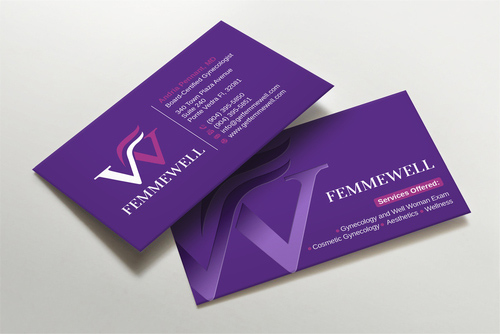
Image Source: ZillionDesigns.com
2. Improves Recall Value
The reason that business cards are still in use is that they conveniently provide contact information and details. It helps in maintaining a cohesive brand identity as people can recall or remember your business when they require a particular service. Even to think of a company later on, clients need to have access to their contact information.
The card contains all of your contact information, such as an e-mail address and a telephone number. Whether you are looking to design digital business cards that impress or in print, you need to consider a memorable layout that includes all the relevant details. In the end, a well-designed card improves recall value and brings over more clients for businesses.
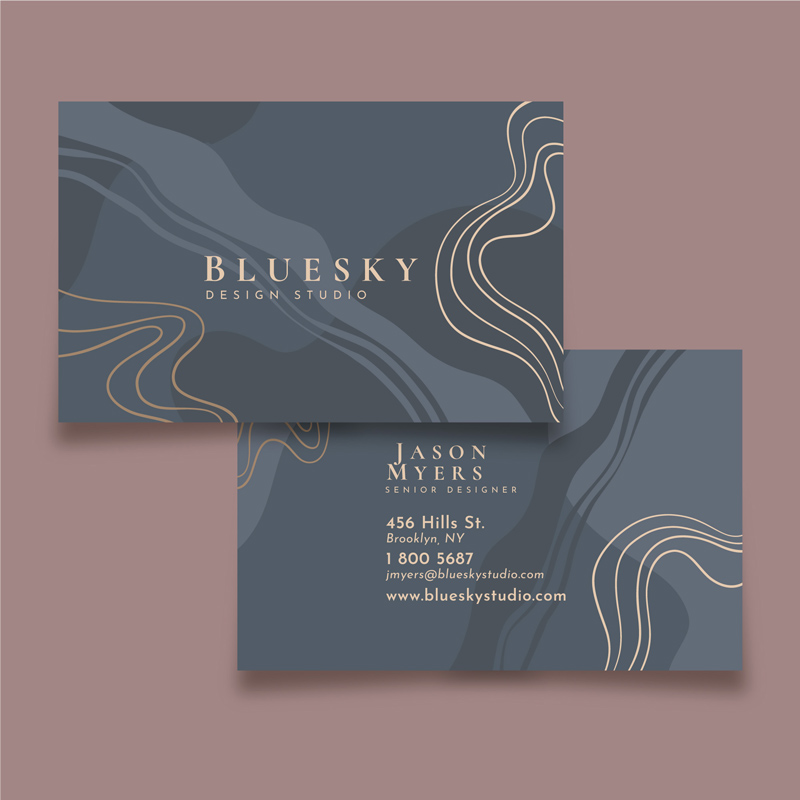
Image Source: freepik.com/freepik
3. Create a Positive Brand Perception
When a business card is handed out, clients do not simply receive contact information. It entails a lot more than just exchanging details. Business cards play an integral role in creating a cohesive brand identity by influencing the perception of a business in the minds of the audience.
With business cards, you can promote your brand and create wider recognition in a short time. They also add a personal touch to communication with potential clients or customers which helps build a positive perception.
Do not, however, forget that the quality of the cards is also important. Personal warmth is important when sharing the cards; however, the quality of the paper and design reminds the client of your professionalism.
4. Draw Attention to USP
Modern business cards are an effective form of direct marketing. Business cards still have the advantage over other marketing methods, such as search engine optimization and e-mail marketing. The reason for this is the in-person meeting associated with sharing the cards. And this proves to be highly useful in drawing attention to a brand’s USP.
Think of it this way. When you consider business cards with unconventional shapes, for instance, they instantly appeal to people visually. They are likely to focus on your unique services or products and even become buying customers.
By highlighting the USP of a business, such marketing tools also play an important role in building a cohesive brand identity. Don’t be afraid to hand over your business card whenever you encounter a potential lead, whether it is in the airport lounge or at an industrial conference.
Keep some business cards in your pocket at all times so that you can hand them out directly to prospects where you come across them.
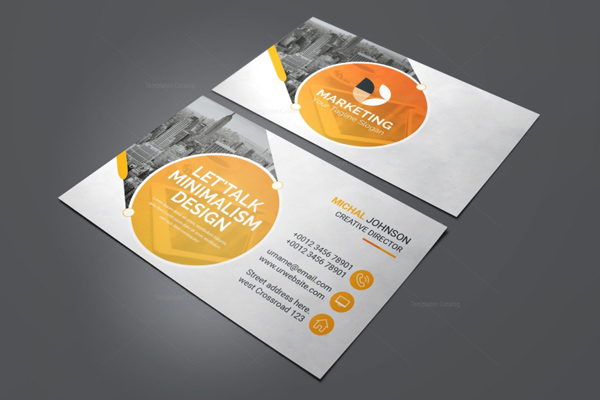
Image Source: templatescatalog.com
5. Communicate Brand Message and Purpose
One of the main reasons why professionals use business cards today is to convey their brand’s purpose and message to the audience. That’s why you need to prioritize designing a modern and professional business card that represents your brand closely.
You must make sure the design of your cards is attractive and communicate the core purpose effectively. Consequently, you should hire a graphic design company that can produce the desired impact through their work.
It is important to utilize the elements of color, text, images, and logos well to reach out to potential clients with the right message.
6. Establish Trust With Clients
As a result of a highly competitive market environment, companies and their products must be trusted by their clients. In the absence of faith in a company’s offerings, customers will not buy anything. This is where cohesive branding with the help of business cards comes into play. It establishes trust and builds credibility.
Sharing the cards also involves a lot of warmth and personal greetings, which contributes to building trust between the parties. In addition to this, a professional graphic designer is aware of the proper use of colors and other design elements to evoke a sense of trust. The design of a business card that appears organized reflects well on the company.
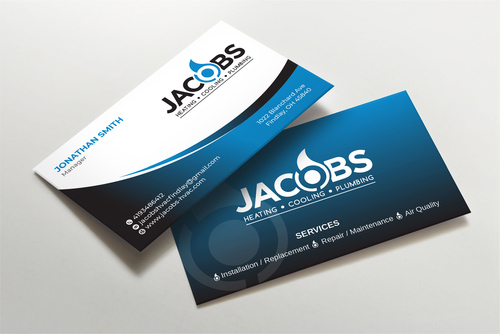
Image Source: ZillionDesigns.com
7. Provides Networking Opportunities
The internet allows you to maintain virtual contact with hundreds of people via electronic means, such as e-mails. While digital business cards work very well in creating awareness and providing networking opportunities, you also need to think about meeting people in person. It is incredibly important for building a cohesive brand identity.
Business cards play an important role in generating business opportunities. By utilizing the power of personal networking, they can increase sales. With the aid of a solid networking strategy, your business will be able to establish its own unique identity.
Furthermore, QR codes and social media handles on your card enable recipients to connect with you online, thereby expanding your network of contacts. Furthermore, you may attract new clients and customers if you distribute business cards with minimalist designs in areas with a high concentration of people, such as trade shows.
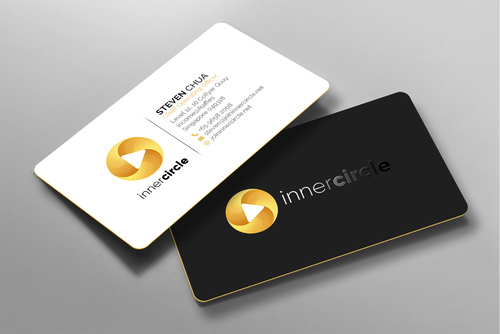
Image Source: ZillionDesigns.com
4 Visual Brand Elements to Include on Business Cards
Be sure to include these elements on your business cards to create a cohesive brand identity for your business. They all should align with your organization’s goals and values.
1. Color
Your business cards must feature your brand colors so that prospects have an easy time recognizing you.
The colors red and yellow come to mind when we think of McDonald’s, while brown and gold come to mind when we think of UPS. Color has a powerful effect so it’s important to choose carefully for your business cards.
Your business cards would look odd if they were red, while your brand colors are blue and yellow. You would create a sense of confusion and inconsistent branding, leading customers to believe that you are not a viable business.
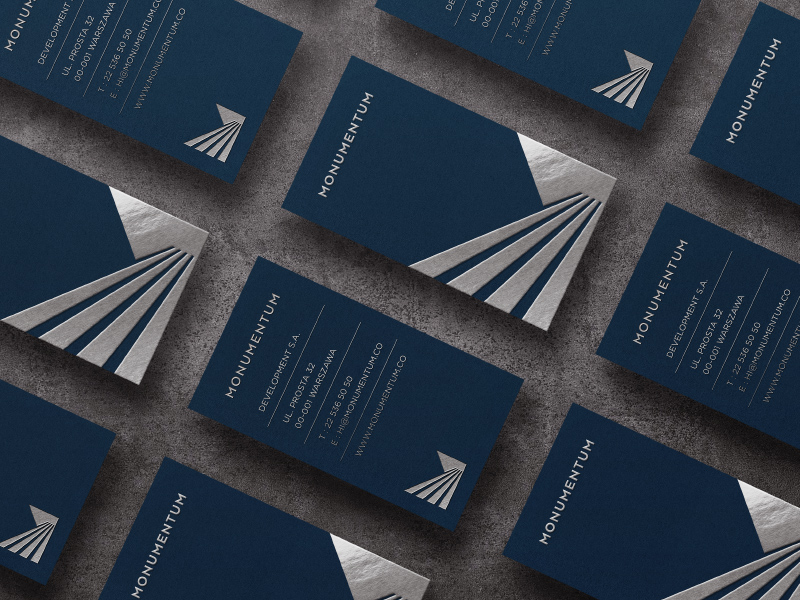
Image Source: dribbble.com/Usarek™ Studio
2. Logo
There is no question that your business cards should feature your logo in some way. Its how you can focus on promoting a cohesive brand identity Consider brands like Nike and Starbucks, which are so well known that they don’t even need to spell out their business name. When we see the Nike logo or the green mermaid, we immediately recognize the brand.
On your business card, you should have your professional logo design somewhere to enhance your brand identity while occupying the least amount of space possible. Remember, there is very little space available to you. Additionally, a well-designed logo can become a symbol of your business’s values and inspire positive feelings among customers.
3. Typography
You should pay as much attention to your typography as you do to your brand colors. Again, you would like your customers to be able to recognize your brand when they see the fonts you use. You should choose a font that is representative of your brand.
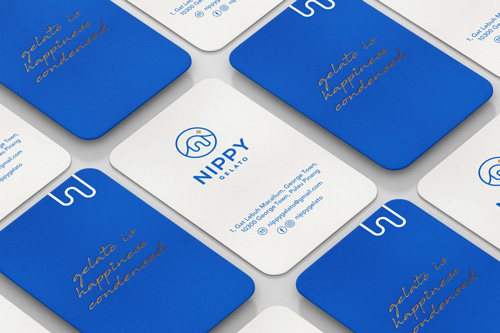
Image Source: teperspective.com
4. Tagline
The tagline or slogan gives the customer a little more information about your brand than the logo does. It also provides a clear picture of what your business does and allows you to distinguish yourself from your competitors.
Additional Tips for Designing Business Cards
Here are some other elements you can add to your business card if you have designed it specifically for branding purposes.
1. Clarify Contact Details
There are several elements that you should include on a business card that are almost always mandatory. The following information is typically included on a standard business card:
- Name and surname
- Position or title of the job
- Email address
- Telephone number
- Address of the business
- Website
- Social media
Business cards should only contain contact information if their purpose is to share contact information. There is, however, much more one can achieve with a high-performance business card.
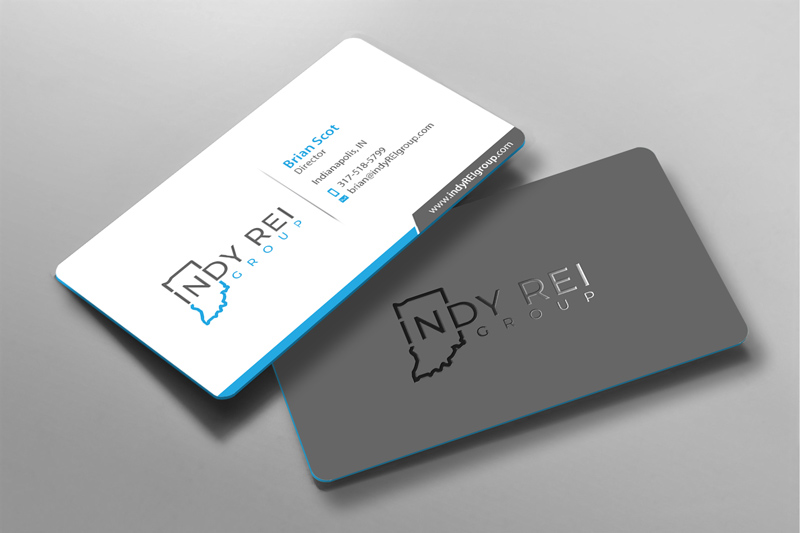
Image Source: ZillionDesigns.com
2. Get the Right Picture
It is easy to increase brand recognition and likability by adding a personal photo to your business card. By doing this, the name becomes familiar to the audience and the person can put a face to the name. Self-portraits drawn by hand are also a creative means of expressing your individuality.
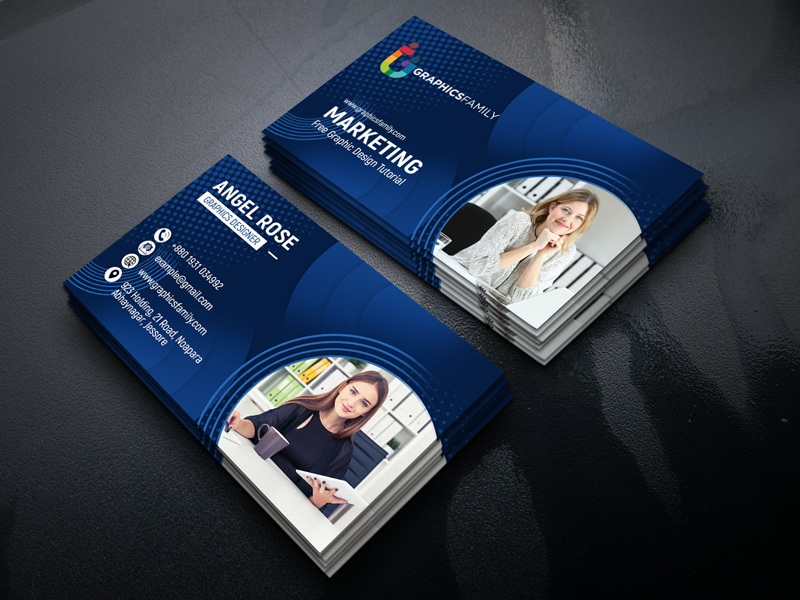
Image Source: graphicsfamily.com
3. Include QR Codes
As email drip campaigns have the goal of getting recipients to take action (e.g. “Sign up”, “Share this”, “Buy now”, etc. ), effective business cards often have an interactive component as well (called a “CTA” in marketing terminology). Scannable QR Codes can help your brand engage potential customers in a world where a smartphone and an online QR scanner are always at hand.
QR Codes on business cards can help direct qualified traffic toward your company’s website, product catalog, pricing list, scheduler, or social media pages. You can now use your business card to generate revenue for your business by super-powering it with a QR code; no more is your business card just a reminder of your brand.
Furthermore, incorporating benefits of Dynamic QR Codes (over Static QR codes) on your business card not only effortlessly guides potential clients to your digital doorstep but also enables real-time updates and tracking of engagement. Ensuring your business card is aligned with modern technological advancements underscores a brand that is forward-thinking and adaptable to change.
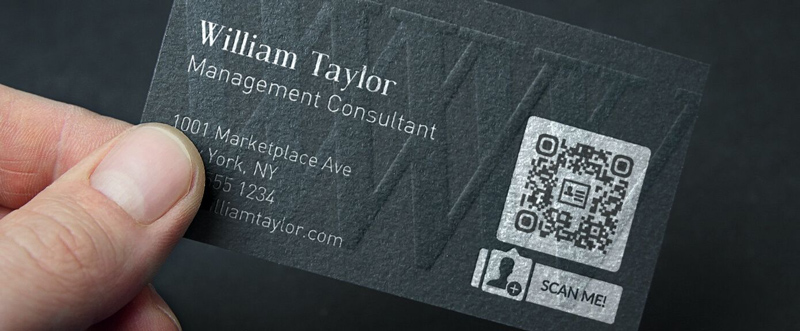
Image Source: qr-code-generator.com
4. Feature Promo Codes or Discount Codes
It is also a good idea to include a promotional or discount code on your business card (your marketer comrades will love this idea). Promotional codes encourage action. Similarly to QR codes, promo codes allow you to track if a campaign (or contact card) draws people in and if they purchase your product.
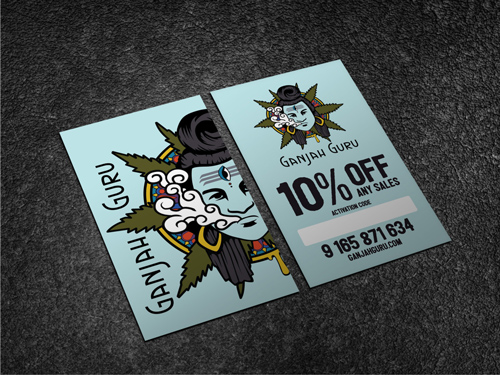
Image Source: designcrowd.com
6. Emboss or Incorporate Matte Finishes
As we discuss ‘elements’, we are not only referring to content. The incorporation of some specialty finishes can transform a conventional design into one that is inspiring. You may want to consider the following enhancements to upgrade your business card’s quality and value for branding.
- Foil stamping in gold and silver
- Coating with a spot gloss
- Rounded corners
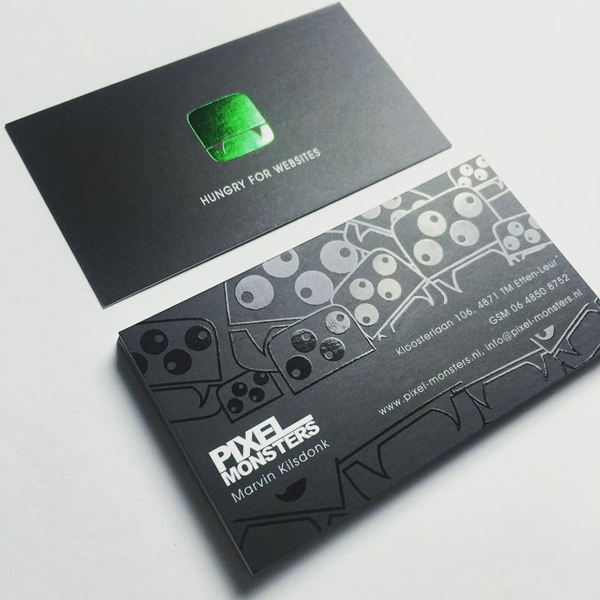
4over4.com
What Are The Different Types of Business Cards?
You must recognize the importance of a quality business card as a business owner. Your business card plays an important role in promoting your business, along with your website and other marketing collateral.
Choosing the right business card for your brand is important, as there are many different types of cards available. Consider the following types of business cards:
- A Standard Business Card. Business cards such as these are the most commonly used and are suitable for a wide range of applications. This typically includes your name, your title, your company’s name, your contact information, and your logo.
- Specialty Business Cards. You should consider a specialty business card if you are serving a specific market or industry. For example, specific cards for real estate agents or photographers contain portfolio samples or listings of available properties.
- Business Cards with a Die-cut Design. Die-cut cards are eye-catching and unique, thus making them ideal for businesses that wish to differentiate themselves from their competitors. Various die-cut shapes are available for this card to allow you to be creative.
- Textured Business Cards. If you are interested in something other than the standard glossy business card, textured cards might be for you.
Conclusion
Besides providing basic contact information and business details, cards are also helpful for creating a cohesive brand identity. They have an integral role in building it from the beginning. You can give it a personal touch and use it for marketing and networking as well as prompting your business.
For branding, use consistent colors and a well-designed logo which you can create with an AI logo maker too, along with other essential elements we have outlined above. Always hire a professional designer for your business cards, as they know very well how to make an attractive and good-looking design.


